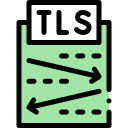
Learn about the meanings of terms and words related to the domain name industry with a simple and easy explanation from the MYHOST of Hosting site team on this page that contains the domain dictionary.
This Domain Glossary contains the most famous terms related to the domain, its types and components, in addition to computer network protocols and Internet protocols, and you can see the meanings and definitions of all of this in this dictionary, which the team of the MYHOSTof Hosting updates continuously and adds more domain terms, Internet charters and networks periodically.
Are you looking for the meaning of a term or word in the domain domain?
There are many terms in the domain names industry, some of which are clear and their meaning can be easily understood, and some of them need to be explained. On this page, you’ll find a Domain Name Glossary with most of the terms explained in a simple way.
If you are looking for the meaning of a word or term that you encountered while buying a domain, renewing a domain, or connecting the domain to hosting, you can find the meaning of that term and explain it in a detailed and simple way so that you can understand the meaning of these terms, their importance, and the mechanism of work of technologies related to domain names and domain components and their importance.
The dictionary of domain names does not stop at the terms of the domain only, but also includes a dictionary of Internet protocols and computer network protocols and an explanation of those protocols or charters, their importance, their uses, and how these protocols work.
In addition to explaining the term, the hosting MYHOST‘s team was keen to provide real-life examples of terms whenever possible so that you can understand the meaning of the term and be able to understand its uses in real life.
Domain and IP dictionary index
The domain dictionary contains a large number of terms, and most of these terms are close to each other in meaning and with similar names, which may make it not easy to access a term in the dictionary. Therefore, the MYHOST of Hosting divided the terms into sections, each of which contains similar and related terms.
Don’t forget to check out our web hosting dictionary that explains more than 50 web hosting terms.
In addition, the MYHOST of Hosting team has created a dictionary index containing the terms in the domain and IP dictionary with a direct link that directs you directly to the site explaining the term on this page when you click on it and you can search the dictionary and filter the terms by typing the term in the search field.
In addition to the index, you can use the search feature on the page in the browser to find an explanation of the term you are looking for in the domain dictionary by clicking the CTRL Button F Together in Windows and Linux or click the button Command With button F in Apple and start typing the name of the term you are looking for.
Types and components of domain
- Domain Name Domain
- Subdomain
- Primary Domain
- Addon Domain
- Parked Domain
- Premium Domain
- IDN
- Uniform URL
- Domain Extension
- Top-Level Domain TLD
- Second Level SLD Domain
- gTLD
- ccTLD top-level domain
- Pasture top-level domain sTLD
- bTLD top-level domain
Buying and transferring domains
- Domain Registration
- Domain Transfer
- Domain Lock
- Domain Transfer Code EPP Code
- Domain Renewal Grace Period
- Domain Redemption Grace Period
- Domain Name Registrar
- ICANN ICANN
- WHOIS
- Domain Privacy
- DNS
- Name Server
- DNSSEC security extensions
- Record Address A Record
- Record IP Address Sixth Edition AAAA Record
- CNAME record
Internet Protocols and Networks
- Network Protocol
- TCP Transport Control Protocol
- Internet Protocol (IP)
- IPv4 Internet Protocol (v4)
- IPv6 Internet Protocol (v6)
- IP Dedicated IP
- Hypertext Transfer Protocol (HTTP)
- Secure Hypertext Transfer Protocol (HTTPS)
- SSL
- Transport Layer Security Protocol (TLS)
- FTP
- Secure File Transfer Protocol (FTPS)
- SSH Secure Transport Protocol
- Secure File Transfer Protocol (SFTP)
Types and components of domain name
Domain Name
A domain name, domain name or domain name is the address of the website on the Internet that visitors use to access the site, browse its pages and obtain its services.

The domain name “Domain” is a text consisting of letters, numbers and symbols and is used to express the website because it is easy to remember instead of using the site’s IP address, which consists of numbers that are difficult to remember.
This is the domain. MYHOST.HOST It is the domain of the MYHOST of Hosting website and is considered its address that you can use to visit the site from any device connected to the Internet in the world by entering it in the address bar of your browser.
The domain is also used for e-mail addresses so that all e-mail messages reach the intended person and to avoid reaching other people.
Subdomain
Subdomain, subdomain, or subdomain A subdomain is an extension of a domain name or a branch of it, as a subdomain is simply an additional part of the main domain.

The subdomain can be likened to your address, if she lives on the fifth floor with one of the residential towers, for example, if we say that the residential tower’s address is the domain, then the floor address here is the subdomain.
Subdomains are used to create semi-independent sites without the need to buy a new domain name for the site, depending on the main domain. Also, the subdomain is useful in many other cases, including:
- Create a blog or forums specific to the main site.
- Create a control panel or portal to manage the service provided by the site.
- Create local websites or copies of the site in other languages such as the MYHOSTof Hosting’s website, Facebook, and others.
- Create sites for the services of the main site, as Google does with some of its services such as Gmail, Google Cloud, Google Drive, and others.
- Create custom sites for mobile or tablet devices like Facebook and many other sites do.
- Create subsites such as WordPress.com WordPress.com Blogger, Tumblr, and other website builders and blog builders.
One of the most prominent examples of sites hosted on a subdomain is the site in which you are now, which is the site of the MYHOST of Hosting, where we use a subdomain that is ar Domain follows MYHOST.HOST Thus, the full domain of the hosting MYHOST is MYHOST.HOST.
An example of this is also the email service provided by Google «Gmail», where it uses a subdomain is mail From Google Domain google.com Thus, the full service link is mail.google.com.
Primary Domain
The primary domain, primary domain name, or primary domain is the primary site domain of the hosting account you used while purchasing the hosting service.
Simply put, if you own one hosting site, the domain of that site is the primary domain and the domain of every other site you create on the hosting account is an additional domain Addon Domain.
Addon Domain
An additional domain name is a regular domain but it is hosted on the same hosting account as your hosting account and is treated the same as your primary or master domain.

The only difference between the Addon Domain and thePrimary Domain is that the primary domain is the domain you used while buying hosting and the primary domain is for your account in the hosting company.
An additional domain is a domain that you use to create a website or email accounts on the same hosting account as your previous site. Thus, the additional domain shares with the main domain in the same hosting server.
Parked Domain
A parked domain name is a domain that has been purchased but is not currently used on a website or in creating email accounts.
ThePremium Domain is one of the most prominent examples of suspended domains, where the owner of the domain, whether a person or a company, stops the domain and displays a simple page to announce that it is available for sale.
An example of a suspended domain is also a newly registered domain before being linked to the hosting, where the domain company displays a simple page for us to visit the domain with information on how to start using the domain.
Premium Domain

Premium Domain Name is a high-value domain that is often short and easy to remember and contains high-value SEO keywords and can be easily converted into a trademark of a company or business.
Because a premium domain contains these advantages, it often gets more visitors than other domains. People and companies specialize in trading premium domains, and the prices of these domains range from hundreds of dollars to hundreds of millions of dollars.
IDN
Internationalized Domain Names, abbreviated to IDN, are domain names that contain a letter or symbol that is not found in the Latin non-Latin script.
Examples include domains that contain Arabic or Chinese characters or even those that contain a Latin alphabet but with ligatures or formations such as French.
Uniform URL
Uniform Resource Locator (URRL) Sometimes known as Web Address or Web Page Address, is a unique identifier for resources on the Internet such as websites, their pages, and their contents of images, audio files, etc.

For example, the URL of this web hosting dictionary page is https://MYHOST.HOST/web-hosting-glossary/ It consists of the following parts:
- https:// Secure Hypertext Transfer Protocol.
- ar Subdomain.
- MYHOST.HOST Domain Name.
- com Domain Extension.
- /web-hosting-glossary/ The path of the page or file name.
Domain Extension
Domain Name Extension is the last part of the domain and comes after the dot . It often expresses the domain’s specialization, geographical location, or the region served by the website.
For example, this hosting MYHOST domain MYHOST.HOST Its extension is com While the domain of this site «Wikipedia» wikipedia.org This extension is used org.

Some of the most commonly used domain extensions include:
- COM It is the most widely used extension (more than half of registered domains) and expresses businesses and businesses.
- NET It is the second most popular domain name extension and expresses networks.
- ORG It expresses non-profit organizations and charitable organizations.
Top-Level Domain TLD
A top-level domain or top-level domain (TLD) is the last part of the domain that comes after the dot sign. ..
For example in the domain of this hosting MYHOST MYHOST.HOST The top-level domain is com We can simply say that the top-level domain is the domain extension..
There are several types of top-level domains such as gTLD,sTLD, andccTLD..
Second Level SLD Domain
A second-level domain (2LD) or SLD is the part of the domain that comes just before the top-level domain.
In the case of the domain of the MYHOST of Hosting MYHOST.HOSTThe scope of the second level is MYHOST.HOST where the top-level domain is com.
In other cases, the second-level domain is part of the domain extension, such as the Google Egypt domain. google.com.eg In this case the top-level domain TLD is eg The second level domain SLD is com Thus, google The third level range is 3LD.
gTLD
Generic top-level domains, abbreviated to gTLDs, are a type of top-level domain that consists of 3 or more characters and operates according to ICANN rules and guidelines only.
One of the most prominent generic top-level domains is the extension of com and an extension net and an extension org and other extensions available for registration by the public that are not subject to country restrictions such as ccTLD top-level domains.
Top-level domains can be categorized into the following:
- Generic gTLDs: which can be used for general purposes such as com and org and info and net.
- Sponsored gTLDs: such as aero and edu and gov and mobi and int and travel and asia Their use is limited to persons and organizations operating in that industry only.
- Generic Restricted gTLDs: These are extensions that can be used for their specific purposes only, such as name and biz and pro.
- Infrastructure gTLDs: It is a single extension of arpa It is used in the domain name system infrastructure only.
ccTLD top-level domain
Country Code top-level domains abbreviated to ccTLD are top-level domains assigned to a specific country or region.
A country top-level domain consists of only two characters, the country code in ISO 3166-1 literal-2, and the management and control of these domains are subject to the state, and countries often place significant conditions and restrictions on the purchase of these domains.
One of these conditions is that you must be a citizen of that country or own an official business entity in it, and the conditions vary from one country to another.
Examples of such domains include:
- eg Special for the Arab Republic of Egypt.
- sa Special for the Kingdom of Saudi Arabia.
- us USA-specific.
- uk UK-specific.
- cn Special to the People’s Republic of China.
Pasture top-level domain sTLD
A sponsored top-level domain (sTLD) is a type of top-level domain that is sponsored and managed by a specific entity, company, or group.
The gTLDs are numbered, most of which belong to the U.S. government, nonprofit organizations, and corporations, such as gov and edu and mil and asia and cat and int and aero.
bTLD top-level domain
Brand top-level domains are new top-level domains that are managed and controlled by brands and large companies, such as .google and .apple and .amazon and .audi and .android and .dell and others.
Back to Index ⬆️
Buy, transfer and set up the domain name
Domain Name Registration

The process of registering a domain name is simply the process of finding a suitable domain for you and buying it from a domain name registrar and the domain must be available for registration and not previously registered in favor of another user and abide by the terms of his top-level domain TLD, which vary from domain to domain.
When you buy a domain, you don’t actually literally own it, you own the rights to use it and it becomes your own only as long as you continue to pay the annual domain registration fee and don’t sell it to someone else.
Domain Transfer

Domain Name transfer is the process of transferring your domain from one domain registrar to another, such as transferring a domain from GoDaddy to Namecheap, for example, while retaining ownership of it.
There are rules and conditions for the domain transfer process, such as that at least 60 days must have passed since the purchase/transfer of the domain, the obligation to open the domain lock, and your possession of the EPP code.
Domain transfer may also mean the process of transferring domain ownership to another person if you sell the domain or want to change its ownership, but this definition is uncommon and rarely used.
Domain Lock
Domain Name lock is a situation in which the domain cannot be transferred to another domain registrar and the “domain lock” must be opened from the current registrar’s control panel so that you can transfer the domain to another registrar.
Domain Transfer Code EPP Code
A domain transfer code or authorization code from the registrar, commonly known as a “domain transfer code”, “authorization code”, Auth code, or EPP code, is like a password for a domain transfer operation.
In order to transfer a domain from one company to another, you will need to obtain the transfer code from the current company and give it to the new company you want to move to.
The domain Authorization code is a unique string of numbers or characters and symbols such as 5Yd!X&Vp@qDXrzj. You can get the domain code from the domain control panel either by copying it directly or by requesting it to be sent to your e-mail.
Domain Renewal Grace Period
The domain has a life cycle consisting of periods, and after the end of the domain reservation period, it does not become available for registration by the public directly, but there is a period in which its owner is allowed to renew the domain to avoid losing it permanently.
The Domain Name Renewal Grace Period is the period immediately after the end of the domain reservation and ranges from 0-45 days, during which you can renew the domain without additional fees, and the domain may remain active during that period, and if it is not renewed within that period, it will enter the grace period for domain recovery..
Domain Redemption Grace Period
The Domain Name Redemption Grace Period is the period that follows and immediately after the domain renewal grace period.
During the “Redemption Grace” period, the domain will stop working and it will not be possible to visit the site or receive emails, and this period extends to 30 days, during which you can renew the domain for an additional non-fixed fee in addition to the regular domain renewal fees.
If the domain is not renewed during this period as well, the domain will be permanently disposed of and will be available for registration by anyone, including its previous owner, within 5 days.
But the domain is often reserved by services and people who specialize in trading expired domains, and the company through which the domain is registered may decide to renew it and in that case it becomes its own.
Domain Name Registrar

A domain registrar is a company or commercial organization responsible for registering a domain to the general public and is accredited by ICANN and operates in accordance with its instructions and rules in the case of gTLDs..
Some domain registrars (domain registrars) provide the service of registering top-level domains in the ccTLD encoding, in which case the service is provided according to the terms and contracts agreed upon with the country or territory that owns the domain extension, and you can see the best domain name registrars from here, arranged according to the tests of the hosting MYHOSTs site.
ICANN ICANN
Internet Corporation for Assigned Names and Numbers (ICANN) is a not-for-profit organization established on September 10, 1998 with headquarters in the United States of America, California.

ICANN works to keep the Internet functioning, secure, and stable, and is responsible for managing, regulating and distributing the DNS and Internet Protocol addresses, issuing domain registrars licenses, setting rules for TLDs, among other matters.
However, contrary to expectations, ICANN does not control the content of the Internet or the sites, but rather helps regulate and develop the Internet and expand the Internet.
WHOIS
WHOIS is an Internet protocol used to query domain registration information or Internet Protocol address in WHOIS databases.
ICANN requires domain name registrants to provide an interactive web page and free service to access domain name data, known as WHOIS data.

The “HOez data” that anyone can access via WHOIS data query tools includes:
- Domain registration, modification/update and expiry dates.
- Domain nameservers.
- Domain status.
- Personal data of the domain registrar (domain owner) and its administrator, such as:
- Domain registrar name.
- The company he works for.
- His email address.
- His address (street, city and state).
- His phone number.
- The company that currently manages the domain.
The confidentiality of this data can be maintained by using the WHOIS Privacy service for an annual fee and provided by some registrants for free, such as Namecheap, and this service replaces the data and information of the domain owner with its own data, which leads to maintaining the privacy of the domain owner.
Domain Privacy
Domain WHOIS Privacy is a service that hides the personal data of the domain owner by replacing it with other data of the same service.

One of ICANN’s rules is that the data of all domain names is available to all people for free through the WHOIS protocol, and this data is called “WHOIS Data”, including the following:
- Domain registration and expiry date
- Name Server for the domain
- The domain owner’s data such as his name, address, email, phone number, and the company he works for.
The domain privacy protection service hides the personal data of the domain owner and replaces it with its own data in order to maintain the privacy of that data while maintaining the ownership of the domain of its original owner.
DNS
Domain Name System (DNS) is one of the basic web systems and is similar to the directory or guide of the Internet.

Each device connected to the Internet has its own unique identifier called an IP address through which that device can be accessed, but that identifier is hard-to-memorize numbers like this one. 123.456.78.90.
Due to the difficulty of saving IP addresses, the DNS appeared that allows replacing these numbers with domain names, which consists of letters and numbers and is easy to remember, and the system converts the domain like this MYHOST.HOST to its IP address without the web user notification.
Name Server
The Name Server, abbreviated to NS, is the server in the DNS and is similar to a phonebook book, and the name server is responsible for converting the domain name to the IP address of the server on which the website is hosted so that the browser can connect to that server and request the web page that it will display to the user.
DNSSEC security extensions
Domain Name System Security Extensions is a technology that can be added to DNS to verify the integrity and correctness of system data.
DNS Security Extensions (DNSSEC) technology relies on adding “Chain of trust” to the system that can be validated and thus the health of each component of the DNS domain.
Record Address A Record
An A record or Address Record (A Record) is a type of DNS record and is considered the most widely used DNS record.
The function of the address record is to bind the domain to a version 4 IP address «IPv4» like this IP 123.456.78.90.
Record IP Address Sixth Edition AAAA Record
AAAA Record or Internet Protocol Address Record IPv6 Address Record (AAAA Record) is a type of Domain Name System record and is a development or extension of the A Record.
The AAAA registry is intended to support Internet Protocol version 6, which is not supported by the A Record, and using the AAAA record, a domain can be linked to an IP v6 address like this. 2001:0db8:85a3:0000:0000:8a2e:0370:7334.
CNAME record
A Canonical Name record, known as a CNAME record, is a type of DNS record that tells the DNS system that this subdomain is the alias of another domain/subdomain.
For example, you can add a CNAME record that directs from mobile.example.com into m.example.com In that case, if the visitor visits mobile.example.com He will see the same content that appears when you visit m.example.com.
One of the conditions for creating CNAME records that must be adhered to is that a CNAME record cannot be created that points to the IP address but only to the Domain name domain. It is also not recommended to create a CNAME record that points to another CNAME record so that the efficiency of the system is not affected, although this is technically possible and there are no obstacles that prevent doing so.
A common example where you’ll need to create a CNAME record is when you have a Blogger and want to use a custom domain instead of using the default subdomain that looks like this. example.blogspot.com. And then you’ll need to create a CNAME record that directs the custom domain such as www.example.com to the Blogger service and thus the blog content will appear when anyone visits the custom domain.
Back to Index ⬆️
Types of Internet Protocols and Networks
Network Protocol

The Communication Protocol or Network Protocol is a set of rules that govern communication between devices connected to a network and how to communicate and exchange data between them.
In ordinary life, for there to be communication between two or more people, the language used in communication must be understood by them, so that each party can understand and understand what the other party is saying and so that there is no misunderstanding.
A protocol, agreement, charter, or standard is closer to the language that devices in the network speak with each other. The protocol consists of a set of pre-agreed standards, controls and rules that make it easy for hardware, hardware and software to communicate with each other and easily understand the data and messages exchanged between them.
TCP Transport Control Protocol
Transmission Control Protocol or Transmission Control Protocol (TCP) is one of the main Internet protocols and is considered the complementary protocol to the Internet Protocol (IP) and both protocols are known together as the Internet Protocol Suite or the TCP/IP Internet model.
In the Internet, data and messages are sent, transferred and exchanged between devices in the form of pieces or parts of the message, and these parts are called data packets or network packets, and one of the most prominent advantages of using this principle is the possibility of sending the message through different methods and collecting it at the final destination without loss or distortion of data while sending it over the network.
TCP communicates between devices and exchanges data between them based on the Internet Protocol, which gives each device its own unique address that enables the device to be identified and not others.
Internet Protocol (IP)
Internet Protocol, abbreviated to IP and colloquially known as “IP”, is the main protocol of the Internet, where it directs data within the Internet from one device to another.

The Internet Protocol does this task by addressing devices, where each device connected to the Internet has its own unique address called the IP address or IP address, and some devices have more than one IP address in some cases.
By obtaining each device its own unique IP address, it is possible to communicate between devices connected to the Internet, as the source device, the target device or the device from which the data is sent, and the device to which the data is to be sent can be identified.
By doing so, it is ensured that the data reaches only the intended device and does not reach another of the billions of devices connected to the network.
IPv4 Internet Protocol (v4)
Internet Protocol version 4 (IPv4) is the fourth version of the Internet Protocol (IP), the most widely used version and is currently responsible for directing most of the Internet traffic, and this version appeared in 1981.

The fourth IP version uses a 32-bit address divided into 4 8-bit fields, making the maximum number of IP addresses that this version can accommodate 4.3 billion unique IP addresses.
This number results from calculating the number of addresses that 32 bits can accommodate by raising/upgrading the number 2 (the number of probabilities of a single bit value in the binary system: 0 and 1) to the exponent of the number of bits like this: 2n where n is the number of bits and 2 is the number of probabilities of one bit.
Since the IP address (version 4) is stored in 32 bits, the number of IPv4 addresses that can be generated 232 The total number of addresses from the calculation of upgrading 2 to the power of 32 results as we can see in this equation:
Number of IP addresses version 4 = 232 = 4,294,967,296 IP addresses.
Each title field is separated by a dot . Thus, the IP address version IV is similar to this address 123.456.78.90.
IPv6 Internet Protocol (v6)
Internet Protocol version 6 or Internet Protocol version 6 (IPv6) is the latest version of the Internet Protocol and was created in order to solve the problem of depletion of Internet Protocol addresses (IPv4) which began to appear in the early nineties and the last available IPv4 blocks were allocated on January 31, 2011.
The IPv6 address consists of 128 bits and can accommodate this version 2128 IP address or equivalent: 340,282,366,920,938,463,463,374,607,431,768,211,456
The IPv6 address is expressed as 8 groups separated by two vertical dots : This is an example of an IP address of version six 2001:0db5:0000:0000:0000:8a2e:0324:5364 This title can be abbreviated to 2001:db5::8a2e:324:5364.
IP Dedicated IP
Dedicated Internet Protocol Address in web hosting is a server or site IP address only and the same address is not shared with other sites or servers.

Shared web hosting often comes with a shared IP address, which means that there are other sites that have the same IP address, and this may negatively affect the security and reputation of your site, especially if one of the sites that share the same IP address is harmful or reputable.
Your use of a dedicated IP ensures that your site(s) are not affected by other sites that may discredit the IP address. When you buy a VPS or rent a dedicated server, your hosting company will probably give you a dedicated IP or you can buy it for an additional monthly or yearly fee.
Hypertext Transfer Protocol (HTTP)

HyperText Transfer Protocol (HTTP) is an Internet protocol that began to be developed in 1989 and the first official version was launched in 1993 under the name HTTP/0.9, an obsolete version that is not currently in use.
Newer versions of HTTP subsequently appeared in the following years:
| HTTP version | Year of issue | His condition now |
|---|---|---|
| HTTP/0.9 | 1991 | Very |
| HTTP/1.0 | 1996 | Very |
| HTTP/1.1 | 1997 | fundamental |
| HTTP/2 | 2015 | fundamental |
| HTTP/3 | 2020 | draft |
The HTTP protocol is the basis for data transmission over the World Wide Web and is mainly used to transmit web pages programmed by the Hypertext Markup Language (HTML), the primary language that makes up website pages.
Secure Hypertext Transfer Protocol (HTTPS)

Hypertext Transfer Protocol Secure (HTTPS) is an extension of HTTP.
In the HTTPS protocol, the connection is encrypted by SSL, which increases the protection of data transmitted between the website and visitors’ devices and increases the privacy of users.
SSL

The Secure Socket Layer (SSL) protocol is an encryption protocol designed to secure communications over computer networks by encrypting data transmitted over a network.
The SSL protocol has been deprecated and is currently not widely used due to many defects and weaknesses that appeared in it, and it was replaced by its successor, the Transport Layer Security Protocol (TLS)..
Transport Layer Security Protocol (TLS)

Transport Layer Security (TLS) is an Internet protocol that is considered the successor to the now deprecated SSL.
The TLS protocol encrypts data transmitted over a computer network, thus securing that data and protecting its privacy, especially on unsecured networks.
Among the most prominent uses of the Transport Layer Security protocol are HTTPS, Email, Voice over IP (VoIP), in addition to instant messaging applications and other applications that need to encrypt the data transferred to and from them.
FTP
File Transfer Protocol (FTP), known as FTP, is a protocol or system used to transfer and exchange files over computer networks that support the TCP transport control protocol and its sister Internet Protocol (IP), the most prominent example of which is the Internet.

FTP is based on the client-server model where there is a computer called a server or server called FTP Server that receives connection requests from other computers that are called FTP Clients.
After establishing an FTP connection between the client and the server, the client can upload files from the server, send or upload files to it, create new files, delete or rename files on the server, and other operations according to the permissions allowed by the FTP server.
FTP relies on two Port ports, port 21 called the command port or control port and its function is to establish the connection between the server and the client, and port 20 called the data port through which data is transferred between the two devices and the FTP connection can be further secured by using FTPS.
Secure File Transfer Protocol (FTPS)

Normally, data transferred via FTP is not secure and that information transferred between the FTP server and the FTP client can be easily accessed.
In order to secure a FTP connection, File Transfer Protocol Secure (FTPS) can be used, which adds an additional layer to FTP that supports SSL, which encrypts the FTP connection.
SSH Secure Transport Protocol

The Secure Shell Protocol (SSH) is an encrypted network protocol that is used to provide services securely over insecure networks by encrypting the connection.
The SSH protocol, introduced in 1995, is based on the server/client model and uses port 22. The protocol enables remote computers to be connected, controlled, commanded, and more.
Secure Shell also supports secure file transfer via SFTP..
Secure File Transfer Protocol (SFTP)

Secure Crust File Transfer Protocol or Secure File Transfer Protocol (SSH File Transfer Protocol) also known as the SSH File Transfer Protocol or SFTP is an extension of the SSH Secure Transfer Protocol..
The Secure File Transfer Protocol (SFTP) provides the ability to securely access, transfer and control files on insecure networks based on the SSH protocol.
Back to Index ⬆️
The hosting MYHOST‘s website team updates the domain dictionary periodically and adds more domain terms, Internet protocols, and computer networks. And if there is a term that you did not find in the domain dictionary above, you can find it in the Hosting Basics series or by searching for it on the website of the MYHOST of Hosting.
If there is a term that does not exist in the domain dictionary and you do not find it in the web hosting dictionary or in the hosting lessons section or in the website of the MYHOST of hosting as a whole, or you want us to add a term to this dictionary, inform us of the term via the comments below and we will add it to this domain glossary God willing, as soon as possible.
